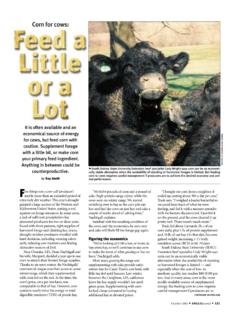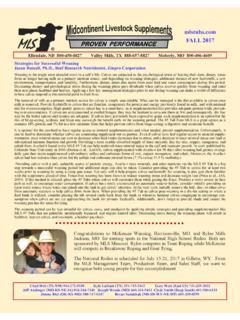Transcription of Dry lot with limited grazing time - Safergrass.org
1 Managing grazing for horses at risk for laminitis dry lot with limited grazing time : If you don't have a large dry lot , make one now. Fence off a portion of your pasture small enough that they will eat it down, and trample and destroy the grass down to bare dirt. A number of horses can destroy grass in a hurry. Just short, stunted grass is NOT appropriate. It must be BARE DIRT. I've always considered that the minimum size for a horse's living space should allow them to gallop comfortably if they wish. That's about 100 X 100 feet. Tillage or herbicide is another option, but a lot more work and trouble, and if you used herbicide it will be a while before you can put your horse in there.
2 If your horse or pony has any of the risk factors for laminitis, proceed with any grazing of green grass with extra caution. Introduction to grass must proceed more slowly than with other horses. Start with no more than15. minutes the first few days, and increase the grazing time only 10 minutes every few days. All during this process observe the horse closely everyday. I like to trot my horses in hand on the way to the paddock, or if the paddock adjoins the dry lot , watch very closely how they travel when you open the gate. If a horse that usually gallops out bucking, walks out slowly and carefully, it's time to get a halter and work them in hand on hard ground to check for laminitic symptoms.
3 If they show ANY signs of being sore footed, they don't go out, and I proceed with first aid measures. Bringing them in after a very short time is a real hassle at first. You many just want to graze in-hand at first, if you have the luxury of quality time . Take a cup of coffee and enjoy sunrise. One horse may have a problem with more than 30 minutes per day; another might tolerate up to 90 minutes fine; another may be able to handle 4 hours. You have to decide. I let mine out at dawn, and since I've learned more about how manage NSC levels in my high-powered, improved grass, I've been able to increase grazing time from 30 minutes to 2 hours per day. When I put out their supplement laced alfalfa mush, they come in on their own to eat that.
4 If your horse can handle a little bit of alfalfa, now might be the good time to give it to them as a bribe. If you make a routine of something they really like after grazing time is over, they learn and come in willingly. Yes, it's a lot more hassle than full time grazing , but a lot less hassle than recovery from founder. It's your decision as what risks you want to take, and how much effort you are willing to make to minimize those risks. The best of times, the worst of times: To better understand these recommendations, a review of Factors Affecting NSC in Grass should be helpful. Safest time to graze: early morning; after a night when the minimum temperature was above 40 F (5 C); on grass that is in a vegetative stage of growth (leaves, not heads) and the grass is under no stress from lack of water or nutrients.
5 Under overcast or shaded conditions, sugar buildup should be slower. A long stretch of cloudy weather will further decrease NSC levels. Most dangerous time to graze: late afternoon or early evening on a sunny day; grass that is heading or flowering; anytime throughout the day if the night before had temperatures below 40 F (5 C); grass that is stressed for lack of water or nutrients; stubble left from mowing or overgrazing, especially in late fall (or winter in areas where grass stays green). Here is a jingle I wrote to help remember : The Fructan Jingle by Katy Watts When you wake at crack of dawn Graze your pony on your lawn But sugars rise in afternoon, For foundered ponies, this spells doom When frosts cause fructans to increase Your ponies grazing now must cease.
6 Hold off a day, or maybe more, Or else your pony may get sore. In my high altitude climate (7,600 ft alpine desert), which is very cold, dry and sunny, my founder prone ponies are being held completely off grass from first green shoots until about the first of June, when it stops freezing at night. They tolerate limited grazing on properly managed, irrigated grass through the summer. When it starts freezing in the fall, they are again kept completely off the paddocks until the grass is dead to the very bottom of the plants. Then I wait until some rain or melting snow can leach out the sugars accumulated while the grass was freezing down. They are then introduced gradually, and they are doing well on the dead grass up to 4 hours a day through the winter months.
7 This seems to be working well for me, and actually when the weather is too cold to ride the time spent walking about grazing has added value as an alternative to exercise and eliminating boredom. A successful grazing management plan will differ for every climate, grass type and be greatly influenced by the degree and sophistication of management inputs. Dead grass: Once grass is completely dead, brown, and desiccated, and has been subjected to enough moisture to leach out accumulated sugars, it will be much safer to graze. If the grass is well adapted to cold, it can stay green forever, and even perk up and start growing under the snow. My grass will stay green with 10 F nights, but will eventually desiccate after the ground dries up completely, due to lack of snow in my area.
8 Any green grass that exists under continuous freezing nighttime temperatures will be VERY high in sugar and fructan, especially if there is plenty of sunshine and no snow cover. Like 5X higher. So they don't need to eat very much to overdose. For more information read this article. Once again we must be aware of selective grazing . I have one horse that will forgo a larger quantity per mouthful to seek out the short green stuff before she'll start eating plentiful dead grass. If you want to try grazing a high-risk horse on dead grass, I would proceed with the same cautions listed above for introduction to green grass. If you've not had much moisture, I recommend getting it tested for NSC content (Equi- analytical, Ithaca, NY ) before grazing a sensitive horse.
9 You'll have to experiment, and remain vigilant. Just do not assume because it's mostly dead that it's safe. The stubble of timothy can contain up to 36% DM as fructan, and the haplocorms (those swellings at the base of the plant that will produce new tillers next spring) can contain up to 49% fructan. [Butler cit.] Don't let them eat it down to dirt, or your grass will suffer next spring. But they miss their buddies, and run and scream . Separation anxiety is not fun, but it's not nearly as bad as another founder. Horses are creatures of habit, and any change of routine will be upsetting. But if you are willing to stick it out for a couple weeks, they CAN get used to a different routine.
10 If you have two horses that need their grazing limited , so they will not be alone, this will help tremendously. But even if just one horse must be kept off grass, you can still ease the stress for both you and your horse. Keep the dry lotted horse where he can see the other horses. Feed him as much low NSC grass hay as you dare to manage his weight. This way they are still eating with their friends, they just have a fence between them. Spreading it around the lot might help simulate grazing , and they need all the exercise they can get. Having a good safe fence really helps. Some horses are more sensible than others, but I'd really try and stick this out for at least a week, unless the separated horse is foolish enough to injure itself in the process.



